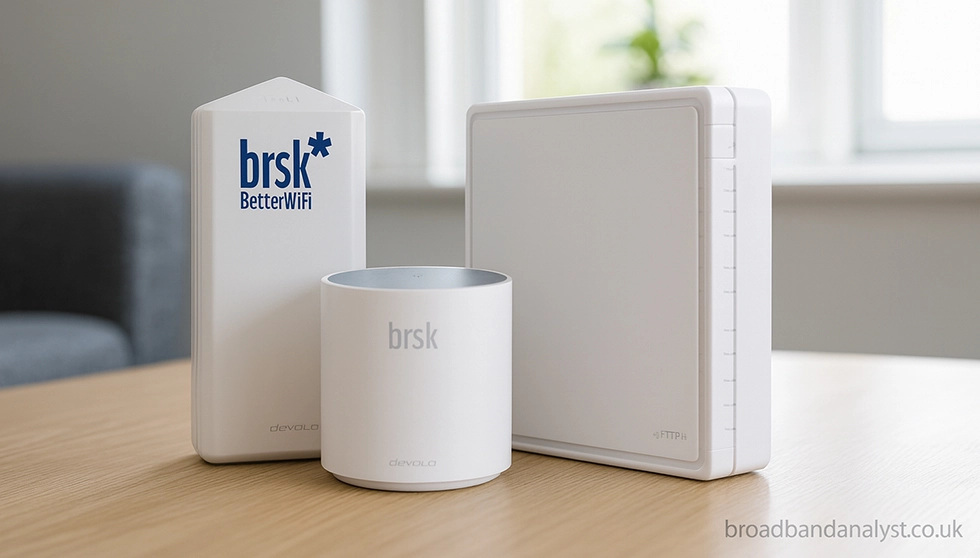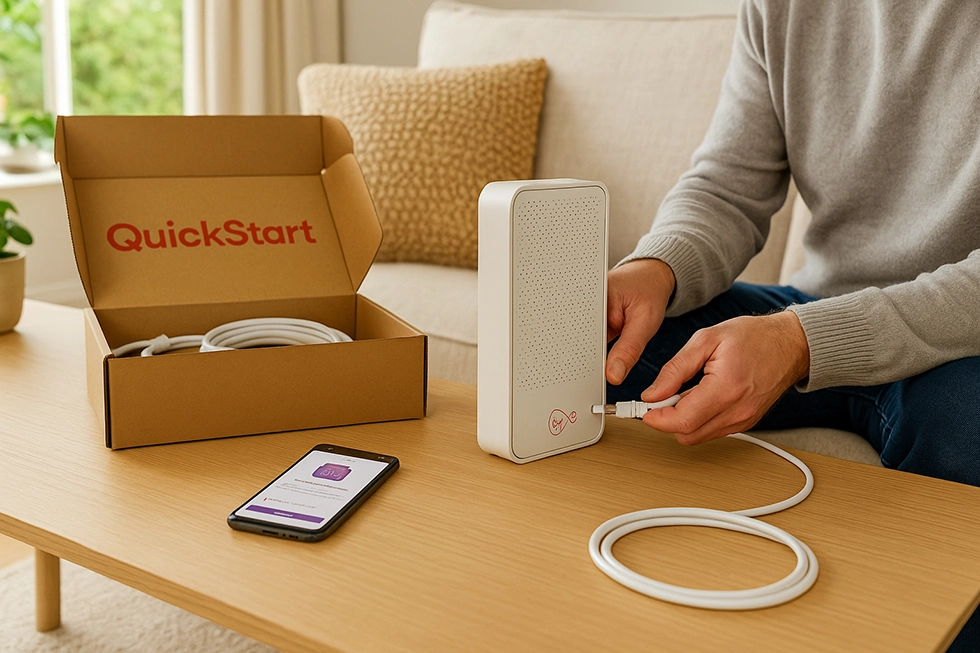Brsk Broadband Review 2025
Brsk is a full fibre broadband provider offering symmetrical speeds at competitive prices, and they don’t raise prices mid-contract.
Customers can choose either an 18-month term or a rolling monthly plan, installation is free, and the sign-up process supports One Touch Switching so moving from another provider is straightforward.

Brsk also stands out for being IPv6-first, with a native /48 prefix delegated to each line. In October 2024 a 2Gbps package launched, and during 2024–25 Brsk became part of the wider Netomnia group while the retail brand remained the same.
What Brsk offers
Brsk focuses on simple, symmetrical full fibre plans with a clear choice of tiers at 150Mb, 500Mb, around 900Mb for gigabit, and 2Gb for multi-gigabit households. Prices are fixed for the length of the contract and installation is shown as free with a stated value of £150. Month-to-month options are also available for people who want flexibility without a long tie-in.
There are a few add-ons to round out the service. BetterWiFi is a whole-home mesh option to extend coverage where a single router can’t reach.
BetterIP provides a static IPv4 address for anyone who needs inbound access, because the standard residential setup uses CGNAT.
BetterPhone adds a digital home phone line over VoIP.
BetterTV is a TV bundle powered by Netgem with a 4K box and app access.
Switching is eased by One Touch Switching, so Brsk can coordinate the move from your old provider as part of the order.
Support operates seven days a week from 08:00 to 20:00, and complaints can be escalated to the Communications Ombudsman if needed.
On the networking side, IPv6 is active from day one using SLAAC and DHCPv6-PD with a /48 delegation, while IPv4 is private by default with the option to add a public static address.
Deals, contract and pricing
The BetterNet plans sit at clear price points on an 18-month contract. BetterNet150 is £24 per month, BetterNet500 is £30 per month, BetterNet1000 is £35 per month with an average of around 900Mb up and down, and BetterNet2000 is £55 per month. For customers who prefer a rolling arrangement, the monthly prices are £33 for 150Mb, £39 for 500Mb, £49 for 1000Mb and £65 for 2000Mb.
TV can be added for £10 per month on a fixed-term plan with a £25 one-off activation. The phone service starts from £4 per month on a pay-as-you-go basis with £9 and £13 options that include call bundles, and number porting carries a £12 one-off fee. A static IPv4 via BetterIP is £5 per month while IPv6 remains included.
Rolling customers can change plan through the account portal and need to give one month’s notice to leave. Fixed-term plans convert to the rolling monthly rate when the minimum term ends.
Router
Brsk supplies different hardware depending on the package and when the service was installed.
On the 2Gbps plan, customers receive the TP-Link EX820v. This is a Wi-Fi 6 AX6000 router with two 2.5GbE ports, one for WAN and one for LAN, plus three additional gigabit LAN sockets. It supports WPA3, has two FXS ports for the digital voice line, and includes a USB 3.0 port. It’s EasyMesh-capable and supports remote management, which helps with diagnostics and optimisation. The multi-gig ports and strong radio performance are a sensible match for a 2Gbps connection, particularly if you have modern Wi-Fi 6 devices or several wired endpoints.
For mesh, Brsk uses TP-Link HX710 Pro nodes with the BetterWiFi add-on. Each node is an AX5400 unit with a 2.5GbE WAN/LAN port and two gigabit LAN ports. This integrates neatly with the EX820v and is designed to carry a strong signal into rooms that a single access point can’t reliably cover.
On earlier or standard installs, Brsk has supplied the Icotera i4850 and the Technicolor DGA0122. Both are Wi-Fi 5 devices with dual-band radios and four gigabit LAN ports alongside two FXS ports. These units are adequate for sub-gigabit tiers, especially for households that rely on wired devices or add mesh to handle coverage.
Customers who want to run their own kit can do so. Brsk uses DHCP on the WAN rather than PPPoE, and IPv6 works with SLAAC and DHCPv6-PD. If you bring your own router, make sure it supports gigabit or faster on the WAN side and can request and route an IPv6 prefix.
Wi-Fi
BetterWiFi is an add-on at £10 per month that supplies engineer-installed mesh nodes to fill dead spots. On the 2Gbps tier, the EX820v router is paired with HX710 Pro nodes for whole-home coverage. The aim is consistent and stable access throughout the property rather than trying to match the full line rate over wireless in every room, which is not realistic at multi-gigabit speeds.
Customer service and support
Support is available daily from 08:00 to 20:00, with phone and email contacts published clearly. Brsk operates a standard complaints process and uses an Ofcom-approved alternative dispute resolution scheme via the Communications Ombudsman. The automatic compensation scheme used by larger providers for missed appointments and delayed repairs does not currently list Brsk, so customers should note that compensation arrangements may differ.
Availability
Brsk primarily serves parts of West Yorkshire, Greater Manchester, Lancashire and the West Midlands. Coverage grows area by area, so a postcode check is the best way to confirm whether your address is ready to order. Since mid-2024 Brsk’s operations have been aligned with the Netomnia platform and the combined footprint has expanded quickly through 2025. Availability remains localised compared to Openreach and Virgin Media, so eligibility will depend on the street and build status.
Is Brsk any good?
Brsk is a strong option where available. Pricing is keen on the 18-month plans, uploads match downloads on every tier, and there is a rolling monthly choice for renters and short-term living arrangements. The networking approach is modern, with native IPv6 and the choice of a static IPv4 for people who need port-forwarding or inbound access. Switching is made easier by One Touch Switching. The 2Gbps bundle pairs sensible multi-gig hardware with an optional mesh that fits neatly into larger homes.
There are trade-offs to be aware of. Residential IPv4 uses CGNAT by default, so anyone running servers, certain CCTV setups or some gaming services will want BetterIP or to use IPv6-friendly tooling. Coverage is still patchy compared to the national networks, so some homes will find Openreach or Virgin Media available where Brsk is not. In mid-2025, Ofcom issued a fine relating to administrative issues around pole deployments; this did not relate to service performance but is worth noting. Brsk also does not appear on the automatic compensation scheme list at the time of writing.
Pros
- Symmetrical speeds on every tier, including entry level
- Sharp 18-month pricing and a month-to-month option
- Native IPv6 with /48 delegation, optional static IPv4 add-on
- Easy switching with OTS and straightforward installation
- Credible multi-gig router and mesh pairing on the 2Gbps plan
Cons
- CGNAT by default on IPv4 unless you add a static IP
- Availability remains location-specific versus larger networks
- Not listed on the automatic compensation scheme
- Recent regulatory fine noted in 2025 relating to pole procedures
Key takeaways
If you can get it, Brsk is an appealing full fibre choice. The value is strong, uploads match downloads, and the networking setup suits modern households. People who need inbound IPv4 should budget for BetterIP, and larger homes may want the BetterWiFi mesh for consistent coverage. Availability will be the deciding factor in many areas, but the overall package is well-rounded.
Verdict
Brsk delivers a high-value full fibre service with simple pricing, sensible hardware and a clear set of add-ons. Gamers, remote workers and home lab users will appreciate the IPv6-first approach and the option of a static IPv4, while bigger properties can add mesh to extend coverage. Where it’s available, it is easy to recommend.
Alternatives
YouFibre often overlaps in Netomnia areas and is worth checking alongside Brsk.
Community Fibre and Hyperoptic offer strong value and symmetrical speeds in select cities and apartment buildings.
Openreach-based providers such as BT/EE, Sky, Vodafone, Plusnet and Zen cover far more homes, with speeds and uploads that vary by plan.
Virgin Media offers wide coverage and multi-gig options in many towns and cities, although uploads are still asymmetric on older cable footprints.
Regional networks like Gigaclear and Fibrus, and providers on CityFibre, may be the best option in specific postcodes.
FAQ
What packages does Brsk sell?
Brsk offers 150Mb, 500Mb, around 900Mb and 2000Mb plans, all with symmetrical upload and download speeds.
Are there rolling monthly options?
Yes. The monthly rolling prices are £33, £39, £49 and £65 for the 150Mb, 500Mb, 1000Mb and 2000Mb tiers.
Is installation free?
Yes. Installation is shown as free with a stated value of £150.
Does Brsk support IPv6?
Yes. IPv6 is native with a /48 prefix, and there is no PPPoE requirement.
Why can’t I port-forward on IPv4?
Residential IPv4 uses CGNAT. You can add BetterIP for a static IPv4 address if you need inbound access.
Can I use my own router?
Yes. The service uses DHCP on the WAN and supports SLAAC with DHCPv6-PD. Check your router supports gigabit or faster and IPv6 prefix delegation.
What router do I get on 2Gbps?
The TP-Link EX820v is supplied, with two 2.5GbE ports and Wi-Fi 6 radios. Mesh nodes are TP-Link HX710 Pro with the BetterWiFi add-on.
Is there a Wi-Fi add-on?
BetterWiFi is available for £10 per month and supplies engineer-installed mesh nodes for whole-home coverage.
How does switching work?
One Touch Switching is supported, so Brsk can handle the move from your current provider as part of the order.
What are the support hours?
Support is open every day from 08:00 to 20:00.
Do they offer automatic compensation?
Brsk is not currently listed as a signatory to the automatic compensation scheme.
